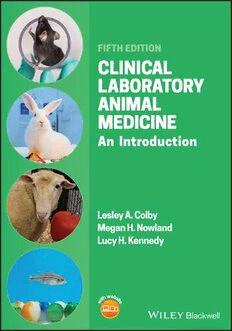
Clinical laboratory animal medicine : an introduction PDF
Preview Clinical laboratory animal medicine : an introduction
Clinical Laboratory Animal Medicine Clinical Laboratory Animal Medicine An Introduction Fifth Edition Lesley A. Colby, DVM, MS, DACLAM Megan H. Nowland, DVM, DACLAM Lucy H. Kennedy, DVM, DACLAM I dedicate this book: • To the memory of all the animals that have contributed both to my education and to the advancement of human and animal health. It has been a pleasure learning from you. • To the animal technicians, veterinary technicians, and veterinarians who have devoted their lives to the care of laboratory animals and in support of animal welfare. It has been an honor working beside you. • To my husband, Ben; our children, Nate and Tess; and our “special” family members (aka dogs), Troika, Ronal Danne, Tasha, and Bacca—for your incredible patience and support through all the nights, weekends, and holidays I spent studying or working over the years. Without you, I would not be who I am today. LAC To my husband, who supports me in all things whether large or unimportant, while reminding me not to take myself too seriously. MHN To Carolyn “Kit” Kestrel Leigh Kennedy, whose timely arrival made completing this book a difficult task! And to Scott and Mer, who made it possible anyways. LHK NOTE The dosages given in this text are derived from published literature, but as few drugs are specifically licensed for use in the species described, the application is often extra‐ label and may be empirical or based on clinical experience. The authors have made every attempt to verify all dosages and references; however, despite these efforts, errors in the original sources or in the preparation of this book may have occurred. Users of this text should exercise caution and evaluate all dosages prior to use to determine that they are reasonable. Contents About the Authors xii Preface xiii About the Companion Website xiv 1 Introduction to Laboratory Animal Medicine 1 Animals Used in Research, Teaching, and Testing 2 Ethical Considerations 8 Organizations 12 Bibliography 17 Further Reading 18 Chapter 1 Review 19 2 Regulations, Policies, and Principles Governing the Care and Use of Laboratory Animals 22 Animal Welfare Act and Regulations 22 Public Health Service Policy on Humane Care And Use of Laboratory Animals 28 Other Regulations, Policies, Guidance Documents, and Organizations 31 References 36 Further Reading 37 Chapter 2 Review 37 3 Facility Design, Housing, Equipment, and Management 39 Laboratory Animal Facility Design 39 Common Facility Classifications 46 Housing 50 vii viii Contents Facility Equipment 59 Management 66 Bibliography 69 Further Reading 69 Chapter 3 Review 71 4 Mice 74 Genetics 74 Microbiologic Classifications 76 Uses 77 Behavior 77 Anatomic and Physiologic Features 78 Breeding and Reproduction 80 Husbandry 81 Techniques 86 Special Techniques: Transgenic Production Technology 96 Therapeutic Agents 101 Introduction to Diseases of Mice 101 Viral Diseases 107 References 114 Further Reading 119 Chapter 4 Review 122 5 Rats 124 Genetics 124 Microbiologic Classifications 125 Uses 126 Behavior 126 Anatomic and Physiologic Features 127 Breeding and Reproduction 129 Husbandry 130 Techniques 133 Therapeutic Agents 143 Introduction to Diseases of Rats 144 Bibliography 157 Further Reading 162 Chapter 5 Review 162 6 Gerbils 165 Uses 165 Behavior 166 Anatomic and Physiologic Features 166 Breeding and Reproduction 167 Husbandry 168 Techniques 170 Therapeutic Agents 176 Introduction to Diseases of Gerbils 176
